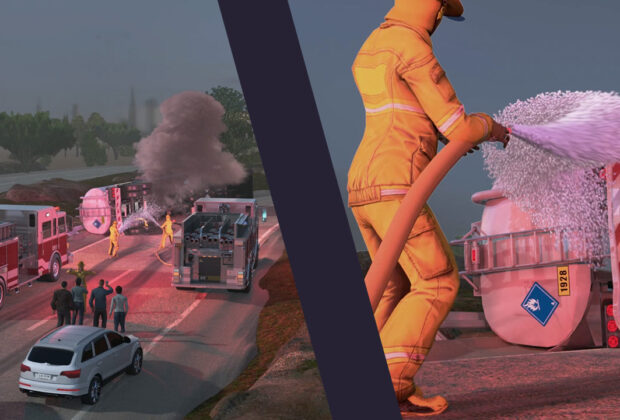Workplace safety isn’t just about rules and posters, but about how people think and act on the job every day.
In Canada, WHMIS (Workplace Hazardous Materials Information System) training plays a key role in building those everyday safety habits. It helps workers recognize hazardous materials, read labels correctly, and make the right choices before an incident happens.
Understanding how WHMIS training connects to real work situations shows why it remains one of the most important safety fundamentals for every industry.
Understanding the Purpose of WHMIS Training
WHMIS is Canada’s national standard for identifying and communicating hazards related to dangerous products used in workplaces. It’s aligned with the Globally Harmonized System (GHS) so that hazard symbols, labels, and Safety Data Sheets (SDS) are consistent and easy to understand across industries.
But WHMIS training is more than a compliance checkbox. It gives workers the practical skills to:
- Recognize chemical hazards before they cause harm
- Interpret supplier and workplace labels accurately
- Find and understand Safety Data Sheets (SDS)
- Respond correctly during spills, leaks, or exposures
Employers are required under federal and provincial OHS laws to provide WHMIS training. But beyond the legal requirement, effective training helps prevent costly incidents, protect health, and improve confidence across the team.
Resource: WHMIS Certifications by Danatec
What’s Changed in WHMIS Regulations?
Navigating the Latest Amendments to the Hazardous Products Regulations (HPR)
In December 2022, Health Canada implemented key amendments to the Hazardous Products Regulations (HPR), officially published in the Canada Gazette, Part II on January 4, 2023. These updates align Canada’s WHMIS requirements with the 7th edition of the Globally Harmonized System (GHS), and certain elements of the 8th edition — often referred to as WHMIS 2025.
Transition Timeline
A three-year transition period is in effect until December 15, 2025. During this time, suppliers can comply with either the former or amended HPR, but not both. This ensures consistency across Canada while allowing time for suppliers and employers to adjust Safety Data Sheets (SDSs), labels, and training programs.
What’s New
The amendments introduce several important updates for workplaces and suppliers:
- New hazard class: Chemicals Under Pressure
- Updated categories: Expanded aerosol and flammable gas classifications
- More detailed SDS requirements: Additional information on physical/chemical properties, ingredient disclosure, and concentration ranges
- Revised hazard statements: Clearer options for combustible dust products
- Enhanced classification rules: Clearer criteria for reproductive toxicity and health hazard mixtures
Why It Matters
These changes improve the accuracy and clarity of hazard information to further help Canadian workers and employers better understand the products they handle. Updated WHMIS training ensures teams stay compliant, informed, and protected as the December 2025 deadline approaches.
Final Countdown: Your WHMIS 2025 Compliance Plan
The December 15, 2025, compliance deadline for the amended Hazardous Products Regulations (HPR) is mandatory. The time to act is now. Here is what this transition means for you:
- For Suppliers: They are responsible for reclassifying all products and updating all Safety Data Sheets (SDSs) and labels to the new standard.
- For Employers: You must update your entire WHMIS program. This includes ensuring your chemical inventory matches the new supplier SDSs and, most importantly, updating your WHMIS training programs to cover the new hazard classes and SDS formats.
- For Workers: You are required to participate in retraining to understand the new classifications (like “Chemicals UnderPressure”), updated labels, and how to read the new SDS formats to protect yourself.
How WHMIS Training Improves Everyday Safety
Builds Awareness and Consistent Habits
WHMIS training helps employees identify what’s hazardous and think before they act. That awareness turns into safer habits — wearing PPE when handling cleaners, storing incompatible products apart, or taking time to check labels instead of assuming what’s in a container.
When people understand the “why” behind the rules, they make safer choices automatically, not just because they have to.
Reduces Chemical Handling Mistakes
Most chemical incidents happen because someone didn’t know — or forgot — how to handle a product safely. WHMIS training gives employees the know-how to label correctly, store properly, and use protective gear as needed.
For example, a manufacturing site in Alberta saw a 40% drop in chemical spills within a year of adding short WHMIS refreshers every quarter. Fewer mistakes meant less downtime, less cleanup, and safer workers.
Improves Team Communication
WHMIS gives everyone a shared language for safety. When workers, supervisors, and safety reps all understand the same labels and symbols, conversations about hazards become clearer and faster.
That shared understanding makes it easier to report issues, ask questions, and fix problems early — before someone gets hurt.
Why WHMIS Training Works: The Human Factor
Good WHMIS training doesn’t just teach facts — it changes how people react in real situations.
Scenario-based or interactive courses help workers practice identifying hazards and responding to emergencies, so their reactions become second nature.
Refresher training reinforces that learning, keeping awareness sharp even years after the first course.
The goal is to move from “remembering the rule” to “doing the right thing automatically.”
Real-World Results
Case 1: Manufacturing Plant in Alberta
After introducing annual WHMIS refreshers, a chemical manufacturing firm cut reportable incidents by 60%. Employee surveys showed a 25% increase in confidence when handling hazardous materials.
Case 2: Logistics & Distribution Company
A national logistics company added short WHMIS micro-learning modules for its drivers. Within six months, compliance scores jumped from 78% to 96%, and employee retention improved — drivers said they felt more supported and informed.
How to Measure the Effectiveness of WHMIS Training
- Gather Employee Feedback: Post-training surveys reveal whether workers actually feel more confident handling hazardous products.
- Track Incidents and Near Misses: Fewer spills or labeling mistakes show that learning is turning into action.
- Audit Labels and SDS Access: Check that labels are clear and Safety Data Sheets are easy to find.
- Monitor Certification Renewals: Regular refresher completions are a good sign that the training process is working — and that safety is being taken seriously.
Digital Learning Management Systems (LMS), like Danatec’s platform, make it easy to track training completions and automate renewal reminders.
Best Practices to Keep WHMIS Training Effective
Blend Online and On-Site Learning:
Online programs like Danatec’s WHMIS Online Training give flexibility, while in-person discussions reinforce how the lessons apply to your specific workplace.
Use Real Examples:
Training sticks better when it relates directly to the chemicals and procedures your team uses every day.
Refresh Regularly:
Even if nothing changes, refresher sessions keep safety top of mind and prevent complacency.
Engage Supervisors:
Supervisors should reinforce WHMIS principles during toolbox talks and inspections.
Recognize Safe Behavior:
Highlight workers who model good safety habits — recognition encourages others to follow suit.
Business Benefits of Strong WHMIS Training
- Lower Incident Costs: Preventing one serious chemical accident can save thousands in cleanup, downtime, and fines.
- Better Audit Readiness: Up-to-date WHMIS documentation and certificates streamline compliance checks.
- Higher Employee Confidence: Workers who understand how to stay safe are more productive, engaged, and loyal.
- Improved Reputation: Clients and partners trust companies that take safety seriously.
Using Technology to Stay Compliant
Modern WHMIS training is easier to manage than ever.
Platforms like Danatec’s online WHMIS training portal let businesses:
- Assign and track courses company-wide
- Download certificates instantly
- Schedule automatic renewal reminders
Digital tracking removes the guesswork and ensures every employee stays compliant year after year.
Common Mistakes to Avoid
- Skipping refreshers when job roles or products change
- Incomplete or outdated Safety Data Sheets
- Poor labeling, especially on secondary containers
- Missing training records
- Using generic WHMIS content instead of job-specific examples
Conclusion: Turning WHMIS Knowledge into Everyday Action
WHMIS training is more than a regulation, but a foundation for safer work habits.
When employees know what they’re working with, understand the risks, and communicate clearly, they make better decisions in every task.
That’s what real safety culture looks like: awareness, accountability, and action.
Ready to strengthen your team’s WHMIS knowledge?
Enroll your workers in Danatec’s WHMIS Online Training today.




Comments are closed.